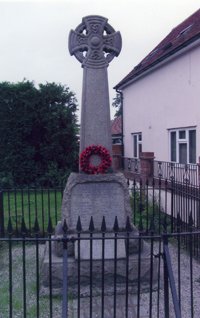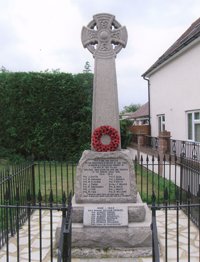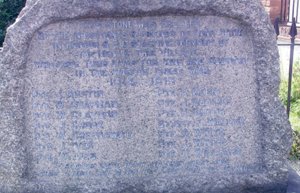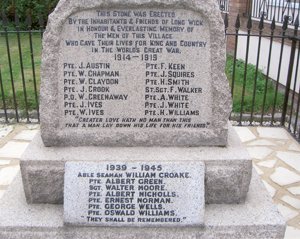Showcase result
Longwick
Town or City: Princes Risborough
County: Buckinghamshire
Country: England
WMT Reference Number: WM2317
Value of grant: £389.00
Type of memorial: Freestanding
Type of work: Conservation and repair
Grant scheme: Small Grants Scheme
Year: 2008
UKNIWM reference number: 8299
 The memorial in the village of Longwick-cum-Ilmer in Buckinghamshire is a granite Celtic cross standing on a rough stone plinth with a rough stone two stepped base. The memorial is surrounded by a paved area and an iron fence. The memorial stands beside Thame Road.
The memorial in the village of Longwick-cum-Ilmer in Buckinghamshire is a granite Celtic cross standing on a rough stone plinth with a rough stone two stepped base. The memorial is surrounded by a paved area and an iron fence. The memorial stands beside Thame Road.
In January 2008 the War Memorials Trust offered a grant of £389 towards work to clean the memorial, to apply masonry biocide and for the repainting of the lead lettering.
On a polished area on the front of the plinth is the inscription:
This stone was erected
by the inhabitants and friends of Long Wick
in honour and everlasting memory of
the men of this village
who gave their lives for king and country
in the world’s Great War
1914 – 1919
 Below this are the names of the men who fell in the First World War. On an additional stone plaque set at an angle on the lowest step, are inscribed the names of those who fell in the Second World War, under the heading 1939-1945, and above the legend “They shall be remembered”. The memorial was unveiled and dedicated by the Bishop of Buckingham on 10th October 1920. Three of the bishop’s own four sons had died in the war and there is a memorial window to them in All Saints Church, High Wycombe.
Below this are the names of the men who fell in the First World War. On an additional stone plaque set at an angle on the lowest step, are inscribed the names of those who fell in the Second World War, under the heading 1939-1945, and above the legend “They shall be remembered”. The memorial was unveiled and dedicated by the Bishop of Buckingham on 10th October 1920. Three of the bishop’s own four sons had died in the war and there is a memorial window to them in All Saints Church, High Wycombe.
We are able to trace the stories of two of the men on the memorial. Pte. James Ives was a member of the 9th Battalion Sherwood Foresters (Notts and Derby Regiment). After training in England the Division received orders on 12 June 1915 to prepare for service at Gallipoli. The Allies had so far failed to make any progress in the Gallipoli campaign and Pte. Ives’ division was to be part of General Sir Ian Hamilton’s new plan to break out of the bridgehead held by the Australians and New Zealanders. The division left from Liverpool on 30 June, with much of the Division sailing on the Aquitania and Empress of Britain. They came ashore at "B Beach" south of Nibrunesi Point shortly before 10 pm on the night of 6 August, part of the Suvla Bay landings. Contemporary sources tell us that this landing was chaotic; destroyers bringing the troops in anchored in the wrong place, causing troops to have to wade in from places where they were up to their necks in water. As some of the landings had been made in pitch darkness units became mixed up and officers were unable to locate their position or their objectives. When there was moonlight, soldiers were picked off by Ottoman snipers. One of the strong points of the Central Powers, Hill 10, was not captured that night because no one knew where it was. Lieut. General Sir Frederick Stopford, the commander of the Suvla Bay landings, had chosen to command the landing from his sloop but as the landing was in progress, he went to sleep. He did not go ashore until 8th August. The corps who landed at Suvla Bay suffered 1,700 casualties in the first 24 hours.
 The soldiers were finally given the orders to break out of Suvla Bay on 9th August. The fighting was intense and gunfire set light to the scrub. The British war correspondent Ellis Ashmead-Bartley recorded "I watched the flames approaching and the crawling figures disappear amidst dense clouds of black smoke. When the fire passed on little mounds of scorched khaki alone marked the spot where another mismanaged soldier of the King had returned to mother earth."
The soldiers were finally given the orders to break out of Suvla Bay on 9th August. The fighting was intense and gunfire set light to the scrub. The British war correspondent Ellis Ashmead-Bartley recorded "I watched the flames approaching and the crawling figures disappear amidst dense clouds of black smoke. When the fire passed on little mounds of scorched khaki alone marked the spot where another mismanaged soldier of the King had returned to mother earth."
Pte. Ives was one of the men to die on that day.
 The other soldier about whom we have information is Able Seaman William Croake. He served during the Second World War on HMS Vernon, a vessel responsible for mine disposal and mine countermeasures, and whose crew were very successful at capturing mines and developing countermeasures. On discovering the skill of HMS Vernon’s mine technicians, the Germans placed booby traps in some mines. One was fitted with a small explosive charge that detonated when the mine was stripped in the mining shed at HMS Vernon on 6 August 1940 causing the deaths of five men, including Able Seaman Croake, and serious injuries to other personnel. Following this, mines were stripped and examined at a disused limestone quarry at Buriton in Hampshire.
The other soldier about whom we have information is Able Seaman William Croake. He served during the Second World War on HMS Vernon, a vessel responsible for mine disposal and mine countermeasures, and whose crew were very successful at capturing mines and developing countermeasures. On discovering the skill of HMS Vernon’s mine technicians, the Germans placed booby traps in some mines. One was fitted with a small explosive charge that detonated when the mine was stripped in the mining shed at HMS Vernon on 6 August 1940 causing the deaths of five men, including Able Seaman Croake, and serious injuries to other personnel. Following this, mines were stripped and examined at a disused limestone quarry at Buriton in Hampshire.
These two contrasting stories show the breadth of activities that servicemen are called upon to perform in war, and the fact that the memorial was dedicated by a man who had lost three of his own sons in the Great War reminds us how personal the memorials were for those in villages and towns when they were erected.
Further information
War Memorials Trust reference WM2317
UK National Inventory of War Memorials: 8299
More on HMS Vernon
http://www.mcdoa.org.uk/History_of_HMS_Vernon.htm
More on Edward Domett Shaw, Bishop of Buckingham
“A Safe Pair of Hands; Bishop Shaw and the Diocese of Oxford” by Peter Gilliat, Amberley Publishing, Winchester SO22 4NB
This book was written by one of Bishop Shaw’s grandsons.
If you have a concern about this memorial please contact the Trust on conservation@warmemorials.org


